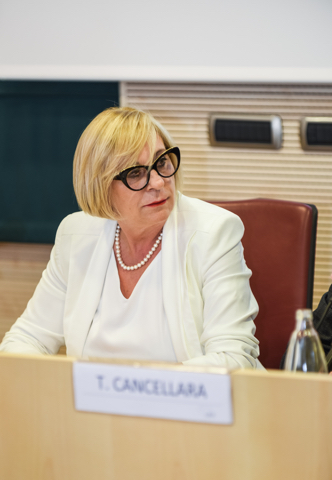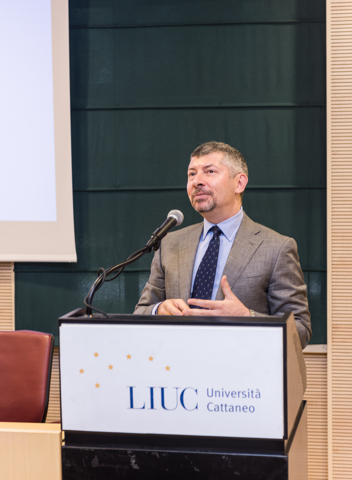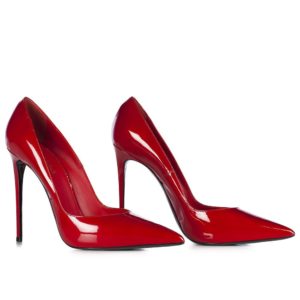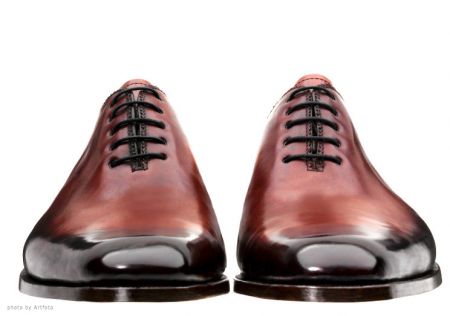With the title “Smart Factory – Italian manufacturing in the running for the development of the Industry 4.0“, the event included the participation of the Undersecretary of Economic Development, Ivan Scalfarotto, together with the President of the University, Michele Graglia, and the Rector, Federico Visconti.
At what is by now a turning point in her term of office, President Annarita Pilotti opened the long annual session by returning to a use of automobile-based metaphors, previously used during her first National Assembly opening speech at the Alfa Romeo headquarters in Arese. At that time, the President was making preparations, with a certain amount of awe and trepidation, “to guide the powerful machine of Assocalzaturifici”. Today, instead, she has gained greater confidence in her role, promising to “no longer respect the speed limits”. Therefore, it seems that maybe the time for pushing things one step further in disentangling the sector from the clutches of the crisis has definitely arrived:

After a 2016 of light and dark – declares the President – we begin 2017 on a cautious note of optimism. Supporting the sector are once again exports, which in the month of March alone registered significant increases that are up 13% from the same month of the previous year, for a total increase that is close to 5% in value and 2% in quantity over the course of the 2017 first quarter. Results that bring back the volumes to the same levels (that were not the best) of two years ago, while at the same time achieving a new record in terms of value.
Signs of an upswing, but not yet a full recovery (a complete report regarding the sector’s results follows below).
Annarita Pilotti accordingly retraces all the political agendas she has supported over these two long years, and which she will continue to support also in the future, in order to achieve the desired result. The most pressing and longstanding issue is that of the EU’s ratification of the “Made in” label: “We would like to see this achieved as quickly as possible, also thanks to the lobbying activities of Confindustria in Brussels. Without an industrial policy that supports the sector, I’m not sure how much longer the supply chain will continue to resist. Italy represents more than a third of European footwear production in quantity and more than half in value: it is the manufacturing platform of all the biggest names in fashion worldwide. However, the great success story that is Made in Italy, with the current conditions of competition, risks experiencing serious repercussions”.
Annarita Pilotti promises to renew the battle against the sanctions in Russia, which are responsible for blocking energies that could 0therwise help provide a boost to Italian exports, and against the much-feared granting of market economy status to China by the EU, which “would effectively cancel out the competitiveness of European manufacturing industries”. Moreover, she expressed hope for the recovery of the TTIP negotiations, while praising the signing of the CETA agreement that eliminated export duties towards Canada, which up until now had been fixed at 18%. She then commended the re-launching of the free trade agreement with Japan, as well as the resumed talks with the member states of Mercosur: markets that are of great interest to Italian exports.
In terms of internationalization, Annarita Pilotti thanked Hon. Ivan Scalfarotto and the Ministry of Economic Development for supporting the national and international trade fair agenda of Assocalzatrifici, and also the newly launched Confindustria Moda, the Federation of Fashion, Textiles, and Accessories, which brings together a network of 67 thousand businesses par excellence in Italian manufacturing, with a turnover superior to 88 billion euros and 580 thousand employees. The synergy of these businesses working together will be increasingly prominent starting from the next edition of the MICAM, to be held from 17 to 20 September in Milan, when, next to the most prestigious Italian footwear manufacturers, also big names in designer fashion will be featured at the fair: Giorgio Armani, Jimmy Choo, Sergio Rossi and Ermenegildo Zegna.
In closing, Annarita Pilotti outlined the two biggest successes of her career: the renewal of the national labour contract and the extension of social safety nets: “The renewal of the contract was extremely difficult: months of negotiations to achieve a wage increase of 70 euros and the creation of a health care fund”. Just as long were the negotiations with the Ministry of Labour to grant eventual redundancy funds also to the footwear manufacturing industry. “A regulation that considered eventual cyclic drops in production was needed: Minister Poletti listened to our motions and took action in a short amount of time, helping to safeguard companies”.

Hon. Ivan Scalfarotto replied to Annarita Pilotti, reaffirming the government’s support of the sector.
We are very happy to have once again made manufacturing and companies our central focal point and we are proud to be the second manufacturing power in Europe. -He then urged Italian entrepreneurs to take a step forward and to tackle the challenge represented by the fourth industrial revolution.- We find ourselves in front of a great revolution and those in power must face great challenges. The choices are to either build a fort around yourselves or try to limit the risks and maximize your business, while monitoring the processes. The fourth industrial revolution will change our way of doing business on every level: the government will be an ally to businesses during this transformation with the Industry 4.0 Plan that has destined 18 billion euros in funds to financial instruments like the super depreciation of 140% and hyper depreciation of 250% for investments in 4.0 machinery and technologies.
Taking an in-depth look at the theme of the Industry 4.0 and demonstrating the potential of a “smart factory” was Professor Raffaele Secchi, Director of the LIUC Business School, who provided the Assembly with a key to interpreting this phenomenon that is “consistent with their business strategies and with the experimentation of new technologies currently under development”. “The Industry 4.0 does not end with an investment in technology, but rather entails changing the industry itself in order to integrate it with the production supply chain and with the subsequent chains of distribution, thus becoming a truly integrated and interconnected system. – explains Professor Secchi – The Industry 4.0 is a genuine engine for development and growth in creating new products and services, and for obtaining greater responsiveness from the markets”.
He ends his speech by outlining the cornerstones of the smart factory: “An ‘Industry 4.0’ business mission, digital map and consistent strategy, company and sector diversification, and supplementary and experimental expertise”.
From theory to practice: the session ended with a visit to the two technical laboratories of LIUC, where entrepreneurs were given a live demonstration of what a smart factory might be like, together with 3D printing demonstrations… allowing them to imagine the future of their very own factories.
Cautious optimism
At the Assocalzaturifici National Assembly, President Annarita Pilotti goes over the sector’s results from the first quarter of 2017, which points towards a path of cautious optimism. Not so much because it is a sign of a genuine recovery, but rather a sign of stability that is accompanied by an encouraging trend of improvement in the overall Italian economic context.
 After a difficult start during the first two months of the year, Italian exports increased by +13% during the month of March, for a final quarterly result of +1.9% in value and +4.9% in quantity. Moderate growth was experienced in the EU (+0.9% in quantity and +1.8% in value), with more consistent results in the non-EU area (respectively +4.4% and +8.7%): in Europe, France is once again on the rise (+3.4% in volume), while Germany slows down (-5%). Outside Europe, the recovery in the CIS area continues (+25.8% in quantity, but always with diminishing prices at -10%), while the Middle East seems to once again be on the rise (+9%). Outside of the EU, Switzerland, the traditional logistics platform, increases by +12.2%, while Turkey drops by more than 20%. In North America, the USA regains its share with a slight +1.5% increase, which is threatened however by the protectionist measures of the new Trump administration. Canada instead decreases by -15%: but in this market expectations remain high, in light of the recently signed CETA agreement. Finally, the Far East slows down, where the duo of China and Hong Kong remain stable (+0.8% in quantity and +1% in value), while the growth trend of South Korea continues (+24% in value) and Japan drops back (-13.3% in volume).
After a difficult start during the first two months of the year, Italian exports increased by +13% during the month of March, for a final quarterly result of +1.9% in value and +4.9% in quantity. Moderate growth was experienced in the EU (+0.9% in quantity and +1.8% in value), with more consistent results in the non-EU area (respectively +4.4% and +8.7%): in Europe, France is once again on the rise (+3.4% in volume), while Germany slows down (-5%). Outside Europe, the recovery in the CIS area continues (+25.8% in quantity, but always with diminishing prices at -10%), while the Middle East seems to once again be on the rise (+9%). Outside of the EU, Switzerland, the traditional logistics platform, increases by +12.2%, while Turkey drops by more than 20%. In North America, the USA regains its share with a slight +1.5% increase, which is threatened however by the protectionist measures of the new Trump administration. Canada instead decreases by -15%: but in this market expectations remain high, in light of the recently signed CETA agreement. Finally, the Far East slows down, where the duo of China and Hong Kong remain stable (+0.8% in quantity and +1% in value), while the growth trend of South Korea continues (+24% in value) and Japan drops back (-13.3% in volume).
While Assocalzaturifici’s members continue to have positive expectations for the markets of China and Russia, the domestic market experiences a halt in its imports (-8.2% in quantity and -0.9% in value), allowing the trade balance to close favourably with a 1,137 million euro surplus, which is up +13% compared to the same quarter in 2016.
During the first quarter of 2017, other encouraging news arrives from the domestic market, which after eight consecutive years of decline that saw families reduce their purchases by more than 30 million pairs, returns to a positive sign of growth: +0.9% in quantity together with a slight +0.2% in value.
A picture that is cautiously optimistic, following a 2016 that could have been better and which was characterized mostly by negative numbers (mainly in terms of quantity) and by an export performance that was limited in its results in the EU and not so favourable in non-EU markets.
 In 2016, the CIS area hit its lowest point since the start of the crisis, to then go on to experience a slight recovery, which however remained below the levels of 2013 by around -40% in quantity and -50% in value. Moreover, the Middle East came to an abrupt halt (-16.7% in volume), while the USA registered a market reversal after six years of positive trends (-5.4%). Overall, exports in 2016 fell by -0.9% in quantity, with an increase of +2.6% in value: 206 million pairs were exported for a value of 8.9 billion euros: only in 2009, during the full-blown worldwide economic crisis, were lower volumes registered.
In 2016, the CIS area hit its lowest point since the start of the crisis, to then go on to experience a slight recovery, which however remained below the levels of 2013 by around -40% in quantity and -50% in value. Moreover, the Middle East came to an abrupt halt (-16.7% in volume), while the USA registered a market reversal after six years of positive trends (-5.4%). Overall, exports in 2016 fell by -0.9% in quantity, with an increase of +2.6% in value: 206 million pairs were exported for a value of 8.9 billion euros: only in 2009, during the full-blown worldwide economic crisis, were lower volumes registered.
In the EU, where 7 out of 10 pairs are destined, France experienced a slowdown, while in any case remaining the first destination for Made in Italy (-5% in volume and -0.6% in value), while Germany (-0.4% and +3.4%) held steady, the Netherlands rose (+2.5%) and the United Kingdom increased (+2.2%), notwithstanding Brexit.
Outside the EU, positive signals arrived from Switzerland (+15.1% in value) and the markets of the Far East (+3.8% in volume and +5.2% in value), which were also the most dynamic, with the duo of China and Hong Kong representing the fifth most important market in terms of value, and South Korea growing by +16.7% in value.
In 2016, imports rose by +2.5% in quantity and by +3.9% in value, confirming China (which accounts for 4 out of 10 imported pairs) as the first supplier. A complex scenario which however has limited its loss in production quantities to only -2%, while exceeding 7.5 billion euros in value, for a +0.8% increase, and reinforcing the trade balance, which is calculated at 4.2 billion euros (+1.3% over 2015).




